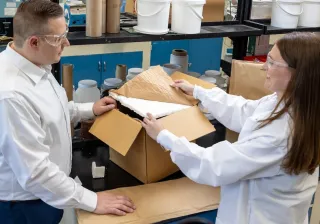Real-time information on the chemical composition of biomaterials during production can soon become a reality, says Mikko Mäkelä, Research Professor at VTT. The critical technology is hyperspectral imaging combined with chemical data science.
Merging hyperspectral imaging with chemical data science is one of the spearhead projects in VTT´s DeepDigital approach. It combines the newest digital tools and methods with industry-specific scientific expertise to create sustainable growth.
Hyperspectral imaging combined with chemical data science enables detailed analysis of different biomaterials. Exciting new applications can be found in many industrial processes where it is necessary to identify materials or evaluate their composition accurately and quickly without sampling.
Hyperspectral imaging provides a massive amount of accurate data on material properties. With the mathematical models of chemical data science, the data is compressed and transformed into interpretable form. Possible applications cover the identification of objects as well as evaluating the chemical variation within an object even as a function of time.
The savings and earnings can be substantial. Processes can run non-stop, the acquired data is accurate, and process control can use the data to make informed decisions.
"We combine digital methods with our deep scientific expertise. This combination makes our offering unique," says Jaakko Kuusisaari, the Customer Account Lead of the bio-based industry at VTT.
Precise identification of biomaterials
One of the most promising application areas for hyperspectral imaging is analyzing the chemical properties of different biomaterials. From monitoring raw material supply to quality control, the list of exciting new applications within the bio-based industry is long.
- Raw material monitoring indicates precisely what is coming into a process so that the materials can be sorted and used accordingly.
- Quality monitoring of pulp, paper or board tells whether you are getting what you want or not. Hyperspectral imaging can check what the filler content of the paper is and how homogenously it is distributed.
- Material identification is crucial in the circular economy. Hyperspectral imaging can separate plastics, metals and non-renewable fibres from renewable ones.
- Moisture analysis and chemical modification in wood construction is a prominent area of application. The wood-processing industry could use hyperspectral imaging instead of taking physical samples.
- Remote sensing of forests could reveal the carbon content of trees, but when performed as a function of time, it could also predict how carbon sequestration proceeds in trees or soil.
All in all, hyperspectral imaging could be used for optimizing the operations of the biobased industry and bringing new products to the market faster.
"We are getting close to applying these methods in optimizing real world operations. We will have tools for producing better and more homogenous materials”, says Mikko Mäkelä.
VTT covers the whole
Today, VTT can cover all aspects of hyperspectral imaging.
"We have all the building blocks from hardware development to image interpretation and chemical data science. We combine this expertise with special context know-how from a specific research area like the bioproduct industry", Kuusisaari says.
VTT has a long history in hardware development for hyperspectral imaging. The reason for this long-lasting interest is the fact that hyperspectral imaging reveals information that would remain hidden from other methods.
"We have developed tunable spectral filters since the 1990s. Today, we have specialized filters for all different wavelength ranges, and we are a world-leader in frame-based hyperspectral imaging", says Antti Näsilä, Microspectrometers Research Team Leader at VTT.
Independent of the final method, application testing with frame-based alternatives can be much quicker than with other alternatives which can further shorten the time required for the actual application.
Uncovering the hidden information makes it possible to create new value
Hyperspectral imaging provides spectral data as a set of images, each image representing a narrow wavelength band of the spectral range. Compared to for example, traditional photography, the amount of information in each image is tremendous.
"We have to compress the information to be able to find what we are looking for. This is the point where chemical data science comes in. We use applied mathematics and develop different algorithms to condense and convert the data into information," Mäkelä explains.
The advantage of VTT's method is its ability to detect chemical differences in individual image pixels and, thus, precisely analyze the chemical composition of different materials. The pixel information can also be analyzed as a function of time.
All-in-all, hyperspectral imaging combined with chemical data science is a very advanced method to visualize chemical material properties.
To find the most useful applications, VTT partners with industry customers.
“We have to figure out where these techniques provide the greatest benefit and business value. The way to proceed is to create impact together with our customers," Kuusisaari says.
Infographic on hyperspectral imaging with chemical data
Hyperspectral imaging combined with chemical data science can accurately estimate chemical properties after, e.g., modification of a wood surface. (Image revised from Mäkelä et al., 2020 based on a Creative Commons license.)















